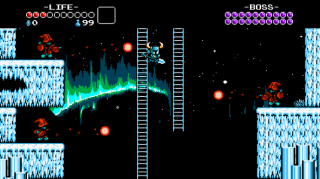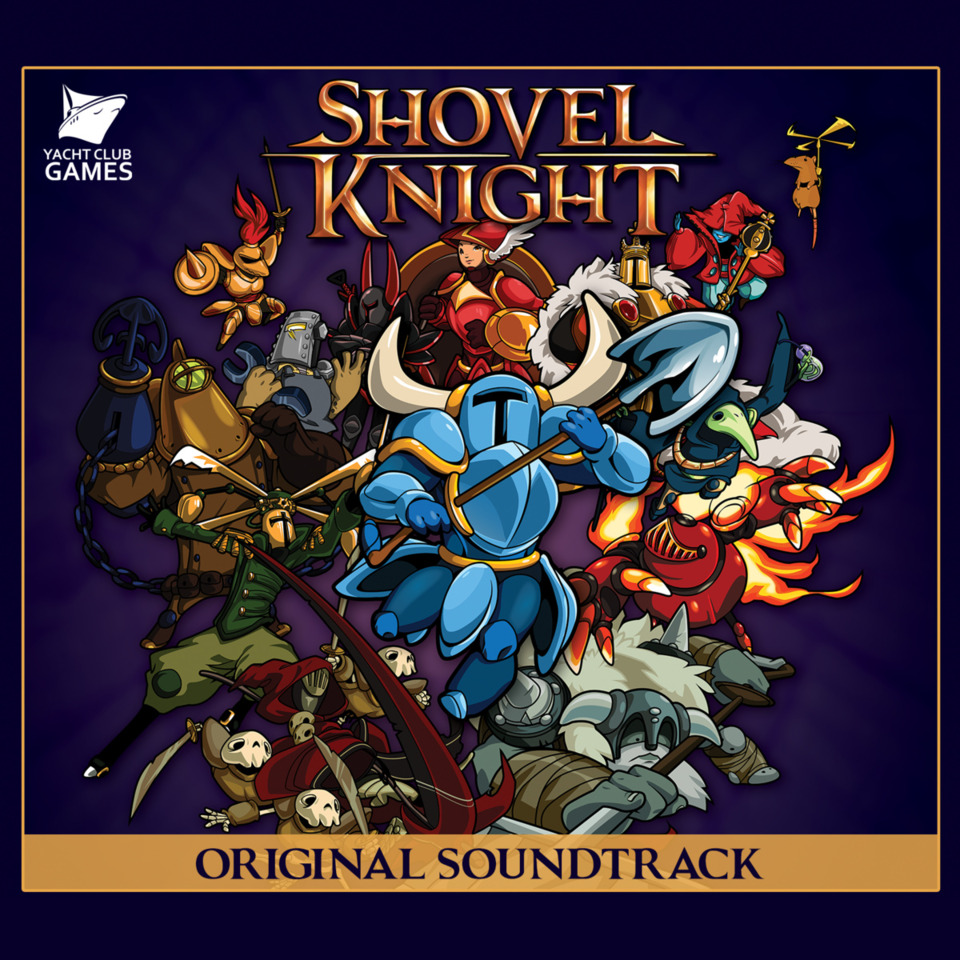Overview
The fearless Shovel Knight has no weapon aside from his trusty shovel which he uses to dig for treasure, lump boulders at enemies or safely jump on otherwise foes and across deadly chasms. On his quest to reach his nemesis, Shovel Knight must travel through woods and volcanoes, across the sea, over mountains, and through the sky in airships.
Yacht Club Games' platforming adventure about a knight and his shovel reached its Kickstarter funding goal halfway through its campaign on March 30, 2013. Jake "Virt" Kaufman is handling the majority of the music. During the the Kickstarter campaign, Yacht Club announced that original Mega Man composer Manami Matsumae would be contributing two songs to Shovel Knight. The Kickstarter campaign ended with pledges totaling US$311,502, well exceeding the original $75,000 goal and fulfilling all stretch goals. Yacht Club stated that stretch goal-features would probably be added to the game post-release via free updates.
Yacht Club Games first showed off the game to visitors at PAX East 2013.
For the Japan release, the game is being published by Nintendo.
Gameplay
Shovel Knight plays in a predominantly side-scrolling 2D style reminiscent of 8-bit games such as Mega Man 2, Ninja Gaiden and Castlevania. There are a few sections of the game where uninterrupted vertical scrolling is used for platforming challenges, but much of the game's verticality is limited to climbing and descending ladders to proceed to the next screen.
Shovel Knight can jump fairly high in relation to his (somewhat short) stature. The player can catch ladders and control his direction in mid-air, and can achieve greater height with the downward thrust (described below). The game's level design is tailored to challenge the player's ability to navigate platforming challenges--bottomless pits, spiked floors, moving platforms, forced scrolling, and the like.
To defeat enemies, Shovel Knight has a melee attack in the form of a single shovel swipe which can only damage enemies to the left or right--he cannot strike upwards. He can also point his shovel downwards to attack enemies below him while jumping, and this maneuver serves a dual purpose in that a successful downward strike results in Shovel Knight propelling himself back up into the air (necessary for navigating certain level design challenges). This mimics the downward thrust mechanic of NES titles Zelda II: The Adventure of Link and Duck Tales. The shovel can be used not only to defeat enemies, but also destroy certain blocks of terrain, deflect certain projectiles, and knock away bombs.
Shovel Knight's melee attack can be upgraded, through purchases, to include a charged-up strike and a full-health projectile attack. His attack upgrades are permanent and stackable.
Shovel Knight is not limited to his shovel for offense and defense, as he can purchase several relics throughout the course of the game. These relics require the use of magic points, and give him various projectile attacks to attack enemies above or below him; at a distance; and surrounding him. Also available for purchase are different suits of armor with varied effects--less recoil when taking damage; less magic consumed when using relics; et cetera. Unlike the weapon upgrades, armor cannot be stacked; the player can only enjoy one set of benefits at a time and must change between purchased suits in order to attain another. Max Health and Max Magic upgrades can also be purchased or found.
With all of the purchasing options out there, the game emphasizes the importance of obtaining and keeping money. There are piles of dirt everywhere that Shovel Knight can dig up, revealing jewels. Breakable walls and treasure chests also present themselves in various situations--obvious, secret, and out in the open but difficult to get to. Enemies also drop valuables. When losing all his health or falling into a pit, Shovel Knight loses a percentage of his money, but it remains around the area where he died for retrieval. Should he fail in retrieving his money before being defeated again, however, that specific allotment of money is lost forever.
Structure
Shovel Knight's progression is a hybrid of linear and open styles. The world map--which stylistically resembles that of Super Mario Bros. 3--opens up one cluster at a time upon clearing out the previous cluster of stages, with each cluster making a few new stages plus some extra areas available. In this way, Shovel Knight guides and restricts the player to complete a few levels within a general difficulty range before being able to move on to a set of levels with greater difficulty. However, the player is still free to choose the order in which s/he tackles the levels within a given cluster.
Each level comes with a particular number of checkpoints, which play a pivotal role in the aforementioned money retrieval system. Shovel Knight can either activate or destroy a checkpoint as he comes across it; in the case of the former, death will send him back to that checkpoint so that the player (a) doesn't have to start at the beginning of the level to complete it and (b) is closer to his or her lost money for easier retrieval. In the case of the latter, where Shovel Knight destroys the checkpoint, the player is granted extra loot... but obviously, the trade-off is that s/he cannot return to that checkpoint if Shovel Knight bites the dust.
While each level does come with a bevy of secret passages and goodies, there is generally only one real path to get from the beginning to the end. Certain exceptions include pathways that may take Shovel Knight in an elevated area of the same passage, but all told, there are no wildly different routes present.

The end of each level takes Shovel Knight to an encounter with one of the rival knights of The Order Of No Quarter. Each rival knight features vastly different attacks requiring a variety of tactics to overcome. Upon defeating every knight, the final road opens, allowing Shovel Knight to take on The Enchantress' castle.
In another nod to Super Mario Bros. 3, while on the world map, random enemy sprites will appear and threaten to collide with Shovel Knight. When this happens, the player will be thrust either into a mini-boss encounter or a special version of a level with the sole purpose being to collect more loot. There are also side areas that aren't full levels, but serve to test the player's skill with a newfound ability.
Modes
New Game Plus
New game plus allows the player to play through the game a second time with all the armor, abilities, gold and stats they earned from the first play through. However, the mobs hit twice as hard, there are fewer checkpoints per level and most of the food items through the levels have been swapped with bombs. The other major change comes from the Tower. The player no longer get a food refill after each boss. It has been replaced with food after defeating two bosses.
Challenge Mode
Challenge Mode will ask the player to complete a specific task such as defeating all enemies or collecting all gems.
Gender Swap Mode
A mode that swaps the genders of all major characters (Shovel Knight, The Enchantress, The Order of No Quarter) excluding enemies. This mode is currently planned but not yet complete.
Battle Mode
No specifics have been announced other than that it will be for up to four players and local play only.
Reception
In its first month, Shovel Knight managed to sell 180,000 copies across all three initial platforms with PC sales being global and Wii U and 3DS being limited to North America only. As of December 2014, total sales reached 300,000 globally across all platforms, now also including Europe and Australia for Wii U and 3DS and additional releases on Mac and Linux.
Soundtrack
 The Front Cover of the Shovel Knight Original Soundtrack.
The Front Cover of the Shovel Knight Original Soundtrack.Shovel Knight Original Soundtrack
Composer: Jake Kaufman
| Track# | Title | length |
|---|
1. 2. 3. 4. 5. 6. 7. 8. 9. 10. 11. 12. 13. 14. 15. 16. 17. 18. 19. 20. 21. 22. 23. 24. 25. 26. 27. 28. 29. 30. 31. 32. 33. 34. 35. 36. 37. 38. 39. 40. 41. 42. 43. 44. 45. 46. 47. 48. | Main Theme Steel Thy Shovel One Fateful Knight Strike the Earth (Plains of Passage) The Rival (Black Knight - First Battle) For Shovelry! (Boss Victory) The Starlit Winds (Campfire Scene) The Adventure Awaits (Map Screen) In The Halls of The Usurper (Prdemoor Keep) The Decadent Dandy (King Knight Battle) High Above The Land (The Flying Machine) The Spin Controller (Propeller Knight Battle) An Underlying Problem (The Lost City) The Claws of Fate (Mole Knight Battle) No Weapons Here (Village) Pastorale (Village Interiors) The Local Happenstance (Village Basement) Watch Me Dance! Spin Ye Bottle (Minigame) A Thousand League Below (Iron Whale) The Bounty Hunter (Treasure Knight Battle) Of Devious Machinations (Clockwork Tower) The Schemer (Tinker Knight Battle) The Destoryer (Tinker Tank Battle) The Donor's Despair (Hall of Champions) Backed into a Corner (Hall of Champions Boss) The Requiem of Shield Knight Waltz of the Troupple Knight The Defender (Black Knight Battle) Courage Under Fire - Armorer Village Bucklers and Bonnets - Armorer Interior Fighting with All of Our Might Flowers of Antimony (The Explodatorium) The Vital Vitriol (Plague Knight Battle) La Danse Macabre (Lich Yard) The Apparition (Spectre Knight Battle) A Cool Reception (The Stranded Ship) The Stalwart (Polar Knight Battle) A Decisive Blow (StreetPass Arena) Fighting Spirit (StreetPass Arena - Fighting Ghosts) End of Days (Endgame Map Screen) The Fateful Return (Tower Approach) The Inner Struggle (Tower) The Forlom Sanctum (Tower Lair) The Possessor (Enchantress Battle) The Betrayer (Enchantress Final Form) A Return to Order (Ending) Reprise (Credits) | 2:43 1:35 1:16 3:44 2:52 00:07 1:38 1:22 3:34 2:56 4:01 2:39 3:48 2:49 3:09 3:10 3:09 1:18 1:55 3:36 2:47 3:41 1:16 3:14 3:19 2:45 3:13 2:41 3:16 3:21 3:20 3:14 3:36 2:39 3:50 2:14 3:57 2:47 1:59 00:16 1:28 3:39 2:59 1:24 2:45 3:42 3:14 2:46 |
System Requirements
Windows
| Minimum |
|---|
| OS: Windows XP SP2 |
| Processor: Intel Core 2 Duo 2.1 ghz or equivalent |
| Memory: 2 GB RAM |
| Graphics: 2nd Generation Intel Core HD Graphics (2000/3000), 256MB |
| Hard Drive: 200 MB available space |
| DirectX: Version 9.0 |
Log in to comment